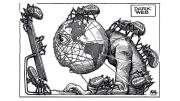Grotesquerie is Kevin “Kal” Kallaugher’s bread and butter. For fifty years the cartoonist has rendered newsmakers in a fleshy museum of knobbly noses, splayed teeth, dewlaps, wattles, and vast foreheads. He’s produced some 10,000 cartoons for the Baltimore Sun and The Economist—in 1978 he became the first cartoonist hired by the latter—and his work is syndicated in more than 100 newspapers worldwide.
Chatty and charming, Kallaugher ’77 grew up in Norwalk, Connecticut, one of five siblings. His mother was a teacher, and father, in his son’s words, an “insurance man.” On Sundays, both parents encouraged artistic activities: they favored oil painting, but spread out the classified section of the New York Times on the kitchen floor and provided a pile of crayons to their children. Something clicked for Kallaugher. “For decades afterwards, [my mom] would tell everybody that I got my start on the New York Times.”
Or perhaps this was the start: in Catholic grammar school, he became a hero to fellow students when he drew a caricature of a nun who was known for rapturously singing with her eyes closed. “I drew her with her curly hair, the big habit…her eyes closed, and her mouth the size of a battleship.” The girl beside him grabbed the drawing, giggled, and passed it along, to increasingly dangerous hilarity. When the good sister found the image, “She made me take a bite out of a bar of soap, and told me not to do it ever again,” he says. But “I’ve been doing them ever since.”
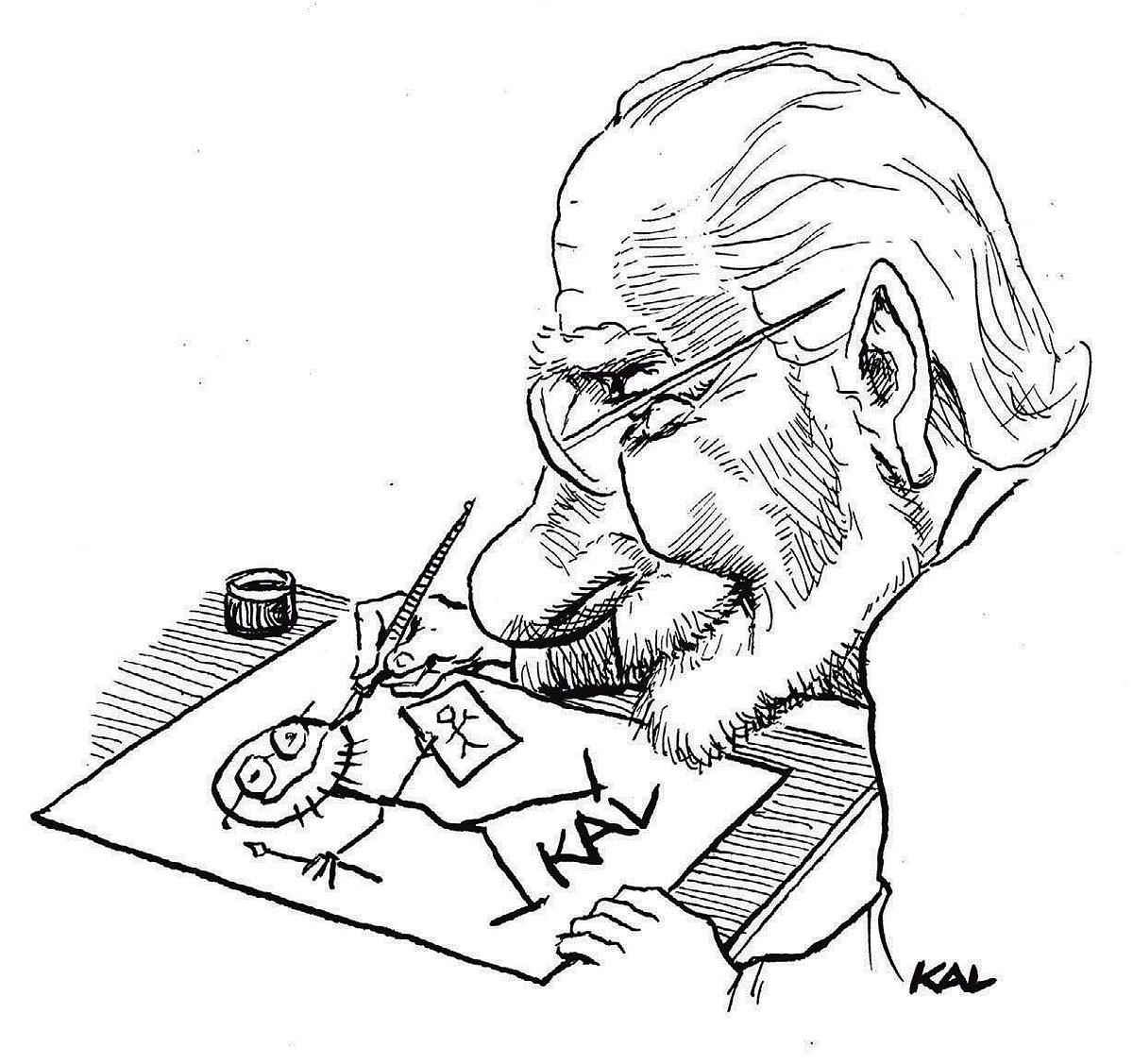
A recent self-portrait drawn for Harvard Magazine
Cartoon by Kal Kallaugher
Dr. Seuss was a major influence, as was a teenage stint as a volunteer at the now-shuttered National Cartoon Museum. There, he met cartoonists like Dik Browne (creator of Hagar the Horrible) and held original comic strip art in his hands. Later, at Harvard, he pursued visual and environmental studies and continued cartooning at student publications. For an article in the Harvard Independent on dorm overcrowding, Kallaugher did a takeoff of the old phonebooth-stuffing gag, with then-President Derek Bok cramming students inside. Bok was not pleased—a frequent experience for an editorial cartoonist, Kallaugher would find. “Word got back to the people at The Independent,”he recalls, “And I’m thinking I haven’t been here more than a few days, and I got the president of the University angry at me!”
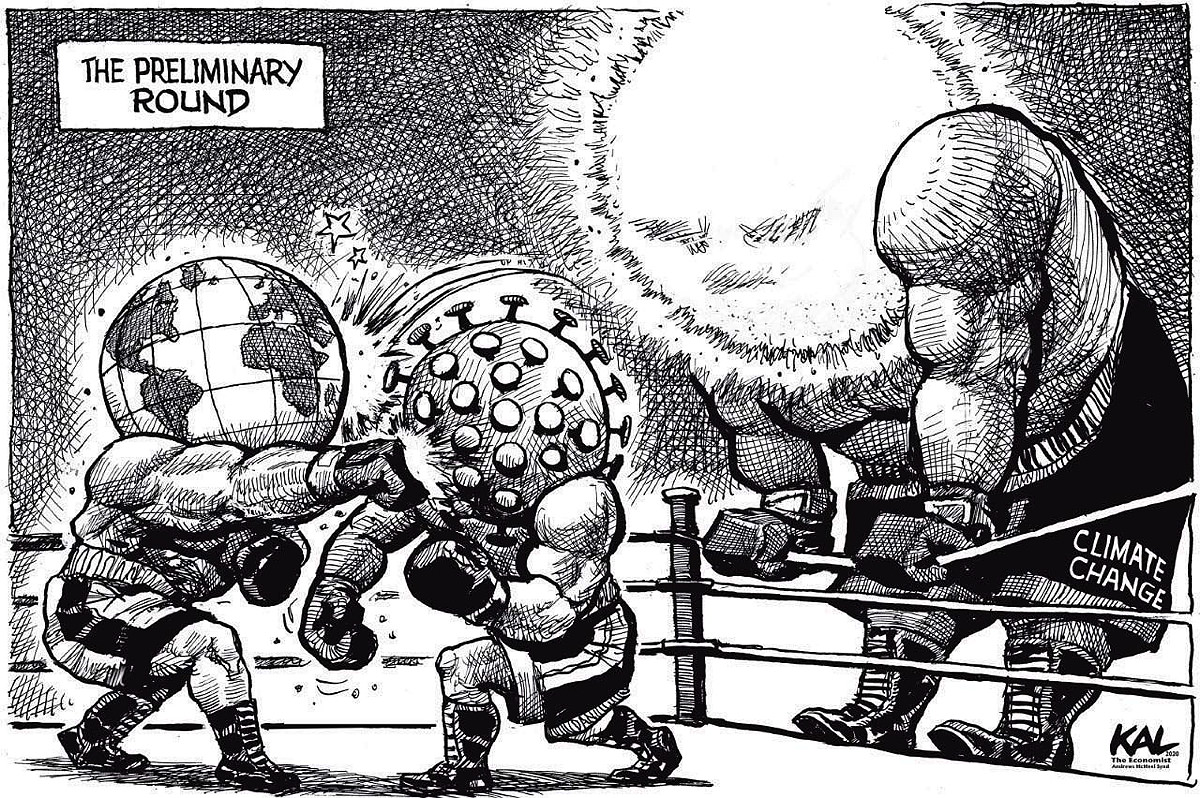
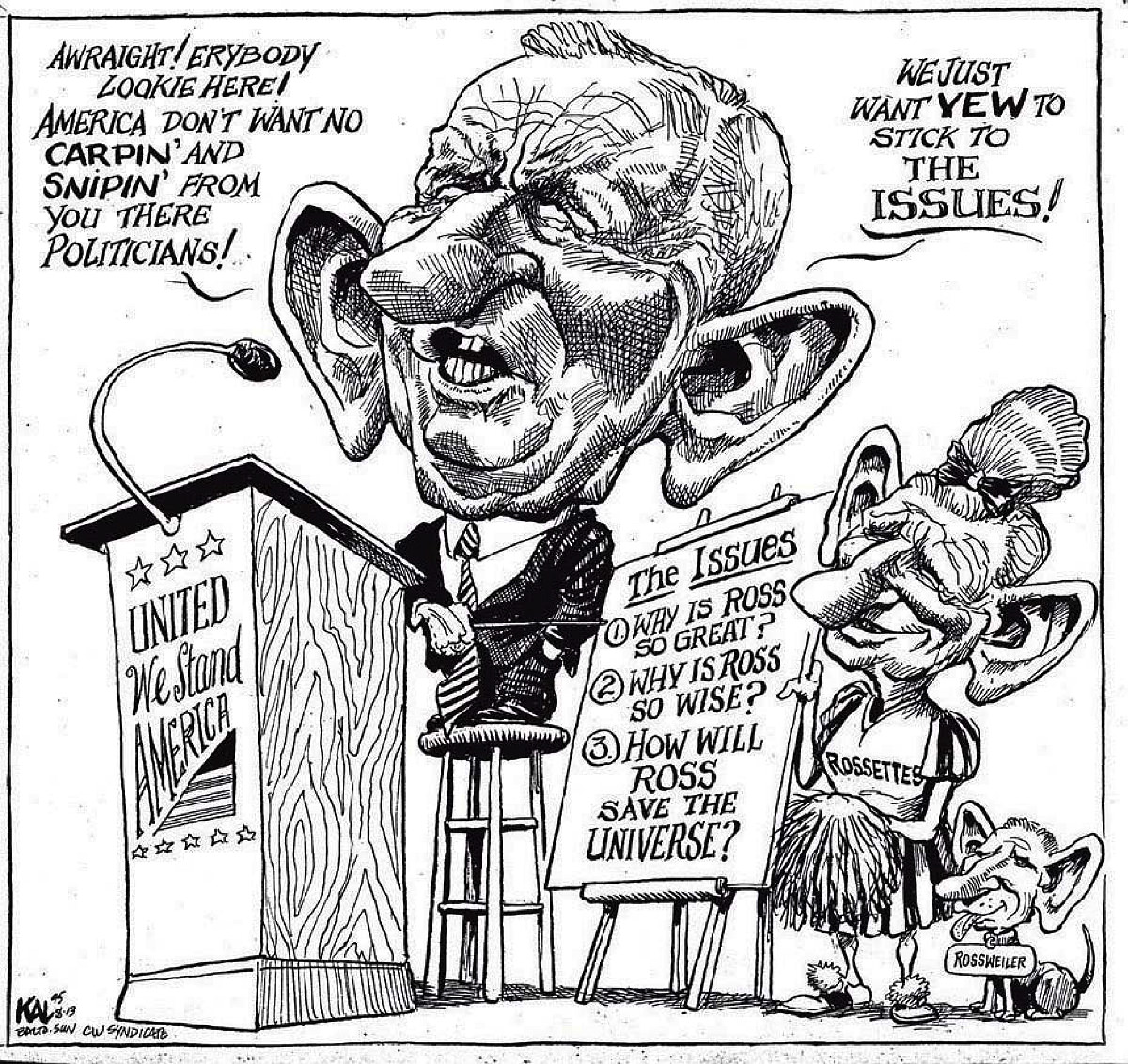
Top: “The Preliminary Round” (2020), Bottom: “Ross Perot” (1995)
Cartoons by Kal Kallaugher
After graduation, he moved abroad and led American teenagers on bicycle tours of England and Scotland. He also played semi-professional basketball: an alumnus of the Harvard Classics club team, he joined the Brighton Basketball Club, which was seeking American players. He played with the team for three years, boarding with local families and supplementing his income by drawing caricatures for tourists.
But he wanted a more regular cartooning job, so he drove to London to show his work to editors. The Economist was his last stop, a magazine known for its spare non-illustrated style. “I’m thinking, fat chance,” he says. “All I had were a half-dozen caricatures of Harvard professors to show them that I did for the Confidential Guide to Classes.” But those Harvard connections worked: several alumni on staff recognized Kallaugher’s caricatures. Plus, the magazine was planning a Harvard-centered article that needed an illustration. They asked him to caricature Henry Rosovsky, then-dean of the Faculty of Arts and Sciences. But they didn’t have any photographs for reference. “‘Can you draw him from memory?’” he remembers them asking. “Oh, my God. I can’t draw my own father from memory, much less Dean Rosovsky!”
Nevertheless, Kallaugher summoned a mental image: big forehead, “Coke-bottle-thick glasses,” and a mole beneath his lip. “And [the editor] goes, ‘Yeah, that’s Dean Rosovsky! That’s great!’” So, there was another 50 bucks.” Kallaugher wrote to the dean afterward, thanking him for the unwitting career boost; Rosovsky responded with a pleasant note. Then 35 years later, when he spoke at Kallaugher’s Harvard reunion, “I walk up and say, ‘Dean, I’m sure you don’t remember me. My name is Kal, I’m the cartoonist for…’ I didn’t even complete the sentence, and he says, ‘Oh, yeah… See? The mole’s on the other side.’”
Despite 10 years in England caricaturing British politicians, Kallaugher says his style never settled there. Nor did he. In 1988, hired as the Baltimore Sun’s editorial cartoonist, he returned to the United States, where he also kept working for The Economist. Over the years, he has exhibited his work at the Tate Gallery in London and the Library of Congress, and he’s won numerous awards in both Europe and the United States, including the National Press Foundation’s Berryman Award for editorial cartoons in 2002 and 2017—the only cartoonist to win twice. In 2015 and 2020, he was a Pulitzer Prize finalist.
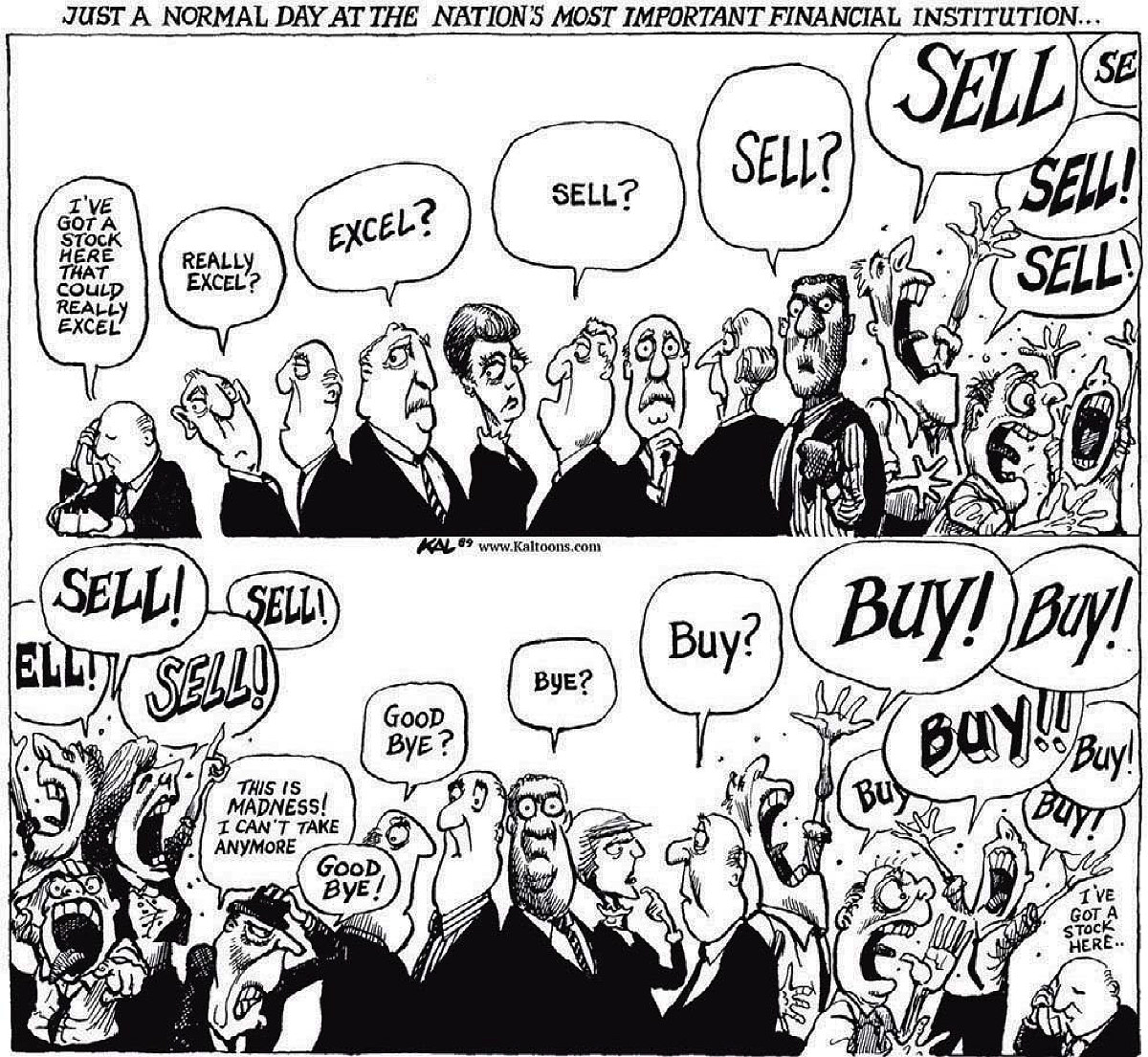
“Buy! Sell!” (1989)—Kallaugher’s most famous cartoon
Cartoon by Kal Kallaugher
His cartoons are known for their visual and emotional layers, intense expressions, heavy inking, and nuanced body language. In a 2021 cartoon called “Dark Web,” a bewildered computer-user, with Earth’s globe for a head, stares into a screen, while hairy spiders labeled “hate,” “misinformation,” “fear,” and “lies” skitter across his body, wrapping him in their webs. From 2020, “The Preliminary Round” shows a boxing match between two competitors: COVID and Earth. While they exchange blows, another, more massive fighter waits its turn outside the ring: climate change.
Kallaugher’s ideas emerge from a process he calls his “production pipeline.” He scans the news and talks with editors and friends, pondering how he feels, what observations he can make, and whether a cartoon is the best medium for an idea. This is followed by frenetic sketching—he scrawls hieroglyphic thumbnails across the page—and more inner dialogues. After getting editors’ feedback on his rough sketches, the heavy-duty artistry begins. It’s a confluence of new and old technology. For heavy cross-hatching, labor-intensive handwork, Kallaugher keeps a repository of pen nibs, some more than a century old and purchased years ago at Philip Poole’s His Nibs pen shop in London. For the final alterations, he uses Photoshop.
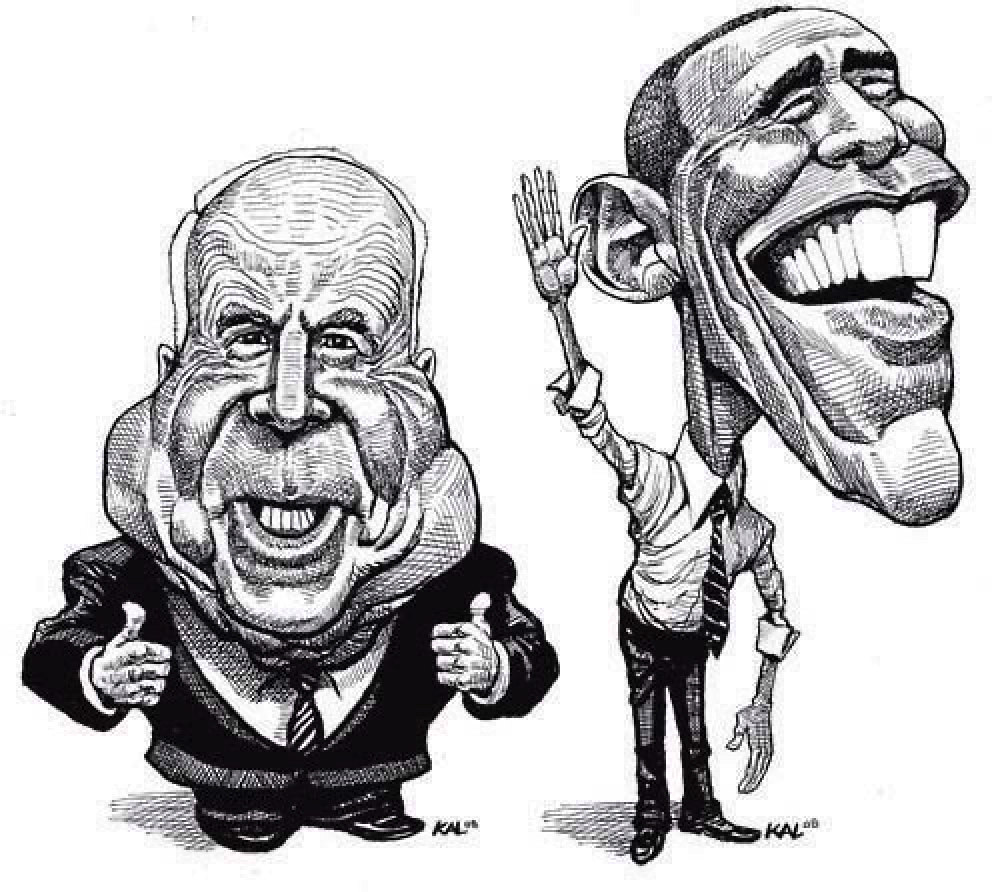
“John McCain and Barack Obama” (2008)
Cartoon by Kal Kallaugher
Foreheads, hair, eyebrows, facial hair, chin, noses, and ears are an editorial cartoonist’s most malleable media, he says. A quote attributed to Italian Renaissance artist Annibale Carracci sums it all up for him: “A good caricature, like every work of art, is more true to life than reality itself.” Asked about his favorite and least favorite subjects, he thinks back. Ross Perot? A living cartoon with his “big ears, big honking nose, and square head”—and thus a big bore. Senator John McCain was a more interesting subject. “He had a Rock of Gibraltar kind of face that could look completely stony. And then his face could explode into a smile that looked like a cherub’s.”
Recently, Kallaugher has stepped away briefly from the news pages to produce a graphic novel aimed at middle-graders. He doesn’t want to reveal too much, but describes the project as having “a heavy environmental theme.” His excitement is clear: “If you imagine that each cartoon is a single frame, a graphic novel is a movie,” he says. “I’d love to be able to transition to that.”
